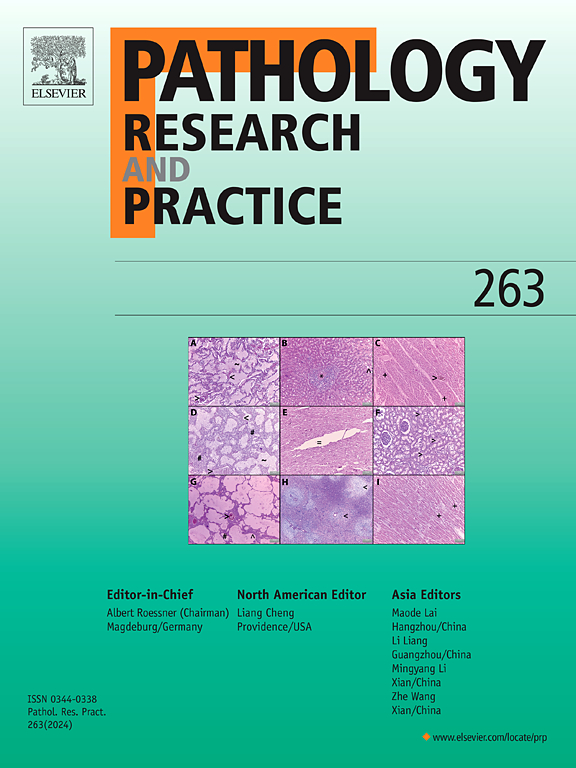miR-17-5p/STAT3/H19:调节年轻乳腺癌患者 ULBP2 表达的新型调控轴。
IF 3.2
4区 医学
Q2 PATHOLOGY
引用次数: 0
摘要
背景和目的:UL-16 结合蛋白 2(ULBP2)是乳腺癌(BC)活化受体 NKG2D 的一种高度改变的配体。然而,其在 BC 患者中的去调控机制仍有待探索。在年轻的 BC 患者和细胞系中,miR-17-5p、lncRNA H19 和 STAT3 之间的复杂串扰可能是 ULBP2 的上游调控环路,这仍是一个尚未探索的领域。因此,本研究旨在揭示年轻的BC患者和细胞系中调控ULBP2的ncRNA回路:本研究共招募了 30 名 BC 患者。与正常人相比,研究人员检测了 30 例 BC 组织中 miR-17-5p、lncRNA H19 和 STAT3 的表达水平。此外,还比较了这些转录本在年轻(-ΔΔCT方法)中的表达特征:结果:H19通过作为ceRNA回路拮抗miR-17-5p的功能,阻止了miR-17-5p诱导的STAT3下调;这一机制进一步促进了BC的发病机制。与模拟细胞相比,在MDA-MB-231细胞中异位表达miR-17-5p能显著抑制致癌介质STAT3和致癌lncRNA H19的表达水平,并诱导TNBC细胞株中ULBP2的表达水平提高3倍,从而显示出它作为NK细胞间接潜在激活剂的突出作用。此外,敲除 STAT3 可抑制 lncRNA H19 并提高 ULBP2 的表达水平,而针对 H19 的 siRNA 可提高 ULBP2 的表达水平:本研究强调了由 miR-17-5p、H19 和 STAT3 组成的新型调控网络之间的相互影响,以及它们对 BC 中 ULBP2 的影响。此外,本研究还强调了 miR-17-5p 通过调节 STAT3/H19/ULBP2 调控轴,在对抗免疫逃避策略,尤其是年轻的 BC 患者的 ULBP2 脱落中的潜在作用。因此,以这一新型调控网络为靶点有可能加深我们对先天系统介导的免疫疗法的理解并推动其在 BC 中的应用。本文章由计算机程序翻译,如有差异,请以英文原文为准。
miR-17–5p/STAT3/H19: A novel regulatory axis tuning ULBP2 expression in young breast cancer patients
Background and aim
UL-16 binding protein 2 (ULBP2) is a highly altered ligand for the activating receptor, NKG2D in breast cancer (BC). However, the mechanism behind its de-regulation in BC patients remains to be explored. The sophisticated crosstalk between miR-17–5p, the lncRNA H19, and STAT3 as a possible upstream regulatory loop for ULBP2 in young BC patients and cell lines remains as an unexplored area. Therefore, this study aimed at unravelling the ncRNA circuit regulating ULBP2 in young BC patients and cell lines.
Patients and methods
A total of 30 BC patients were recruited for this study. The expression levels of miR-17–5p, lncRNA H19, and STAT3 were examined in 30 BC tissues compared to their normal counterparts. In addition, the expression signatures of those transcripts were compared in young (<40 years) and old BC (≥40 years) patients. miR-17–5p oligonucleotides, STAT3 and H19 siRNAs were transfected in MDA-MB-231 cells using HiPerfect® Transfection Reagent. miR-17–5p and the transcripts of the target genes quantified using RT-qPCR. Their relative expression was calculated using the 2–ΔΔCT method.
Results
Through acting as a ceRNA circuit that antagonizes the function of miR-17–5p, H19 prevented the miR-17–5p-induced downregulation of STAT3; this mechanism further contributes to the pathogenesis of BC. Ectopic expression of miR-17–5p in MDA-MB-231 cells displayed its prominent role as an indirect potential activator of NK cells by significantly repressing the expression levels of the oncogenic mediator STAT3 and the oncogenic lncRNA H19 and inducing ULBP2 expression level by 3 folds in TNBC cell lines compared to mock cells. Furthermore, knocking down of STAT3 repressed the lncRNA H19 and increased ULBP2 expression levels, whereas siRNAs against H19 increased the expression levels of ULBP2.
Conclusion
This study highlighted the crosstalk between the novel regulatory network composed of miR-17–5p, H19 and STAT3, and their impact on ULBP2 in BC. Moreover, this study underscored the potential role of miR-17–5p in counteracting the immune evasion tactics, particularly the shedding of ULBP2 in young BC patients, through the modulation of the STAT3/H19/ULBP2 regulatory axis. Thus, targeting this novel regulatory network could potentially enhance our understanding and advance the future application of the innate system-mediated immunotherapy in BC.
求助全文
通过发布文献求助,成功后即可免费获取论文全文。
去求助
来源期刊
CiteScore
5.00
自引率
3.60%
发文量
405
审稿时长
24 days
期刊介绍:
Pathology, Research and Practice provides accessible coverage of the most recent developments across the entire field of pathology: Reviews focus on recent progress in pathology, while Comments look at interesting current problems and at hypotheses for future developments in pathology. Original Papers present novel findings on all aspects of general, anatomic and molecular pathology. Rapid Communications inform readers on preliminary findings that may be relevant for further studies and need to be communicated quickly. Teaching Cases look at new aspects or special diagnostic problems of diseases and at case reports relevant for the pathologist''s practice.

 求助内容:
求助内容: 应助结果提醒方式:
应助结果提醒方式:


